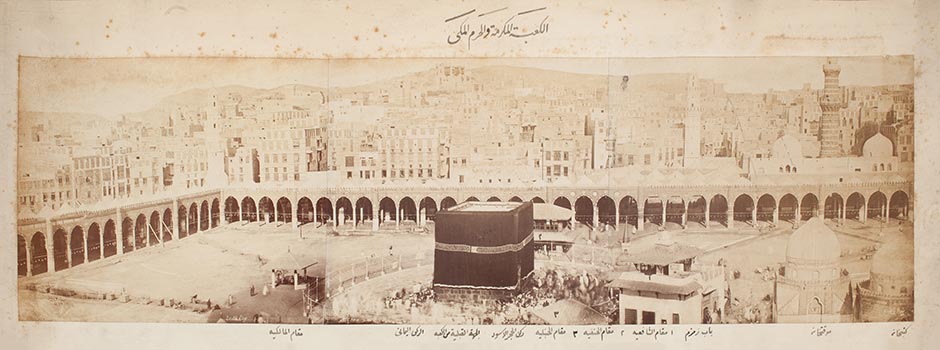
ART AUCTION (June 17, 2019) Millon Auction House Presents Islamic Arts and Orientalist Paintings Sale
Jun 15, 2019 EVENT, Art Auction

Amongst the 350 lots presented at the auction, you will find more than 80 middle eastern manuscripts regarding Religion (Quran), Astronomy, Medicine, Poetry and War, as well as ceramics and metals from Mesopotamia, Ottoman Turkey, and Persia. From Andalusia to Mughal India, the auction will bring you to the heart of Oriental cultures.
Orientalist Paintings will open the auction. Three landscapes by George Washington who studied painting alongside François-Edouard Picot (1786-1868), a painter of history and battles. Finding education in the Fine Arts boring, he visited Algeria, stayed in Morocco in 1879, and then in Hungary, Bulgaria, and Turkey. In 1881, he went to Moscow where his paintings are exhibited. His works are mainly landscapes, stalls, fantasias, encampments and hunting scenes.
_Soldiers_in_the_mountains_and_at_edge_of_the_wadi_oil_on_canvas.jpg) Georges Washinton (Marseille 1827 - Douarnenez 1901), Soldiers in the mountains and at the edge of the wadi. Original oil on canvas, 75 x 90 cm. Signed lower right G Washington. Estimate: 10,000 / 12,000 Eur / Courtesy of Millon Auction House
Georges Washinton (Marseille 1827 - Douarnenez 1901), Soldiers in the mountains and at the edge of the wadi. Original oil on canvas, 75 x 90 cm. Signed lower right G Washington. Estimate: 10,000 / 12,000 Eur / Courtesy of Millon Auction House
_Houses_in_the_Algerian_desert.jpg) Jacob Dirk VAN Herwerden (Zutphen 1806 - The Hague 1879), Houses in the Algerian desert. Oil on canvas rented 29 x 42 cm. Signed and dated D van Herwerden, 1865 lower left (Restorations). Estimate: 2,000 / 3,000 Eur / Courtesy of Millon Auction House
Jacob Dirk VAN Herwerden (Zutphen 1806 - The Hague 1879), Houses in the Algerian desert. Oil on canvas rented 29 x 42 cm. Signed and dated D van Herwerden, 1865 lower left (Restorations). Estimate: 2,000 / 3,000 Eur / Courtesy of Millon Auction House
_The_fountain_in_Tunis_Oil_on_canvas_mounted_on_cardboard.jpg) Alexandre Roubtzoff (Saint Petersburg 1884 - Tunis 1949), The fountain in Tunis, Oil on canvas mounted on cardboard, 41 x 54 cm. Signed dated and located lower right: In Roubtzoff Tunis 1917. Origin: Special collection. Estimate: 30,000-50,000 Eur / Courtesy of Millon Auction House
Alexandre Roubtzoff (Saint Petersburg 1884 - Tunis 1949), The fountain in Tunis, Oil on canvas mounted on cardboard, 41 x 54 cm. Signed dated and located lower right: In Roubtzoff Tunis 1917. Origin: Special collection. Estimate: 30,000-50,000 Eur / Courtesy of Millon Auction House
A selection of Arabic, Indian and Persian manuscripts is divided through the catalogue by chapters: The Quranic manuscripts, and more particularly a very rare folio in gold Kufi, a complete Mamluk Qur'an, a beautiful illuminated Quran from the Caucasus, probably Daghestan, and a Bucharest copy; The prayers books, as Dala al-Khayrat and others; Science treatises, as astronomical or medicinal treatises and calligraphies; Persian poetry.
 An illuminated calligraphic panel (qit’a), signed by Al-Sayed Hafez al-Rasimizade, Ottoman Turkey, in the second half of the 19th century. Estimate: 1,000 - 1,200 Eur / Courtesy of Millon Auction House
An illuminated calligraphic panel (qit’a), signed by Al-Sayed Hafez al-Rasimizade, Ottoman Turkey, in the second half of the 19th century. Estimate: 1,000 - 1,200 Eur / Courtesy of Millon Auction House
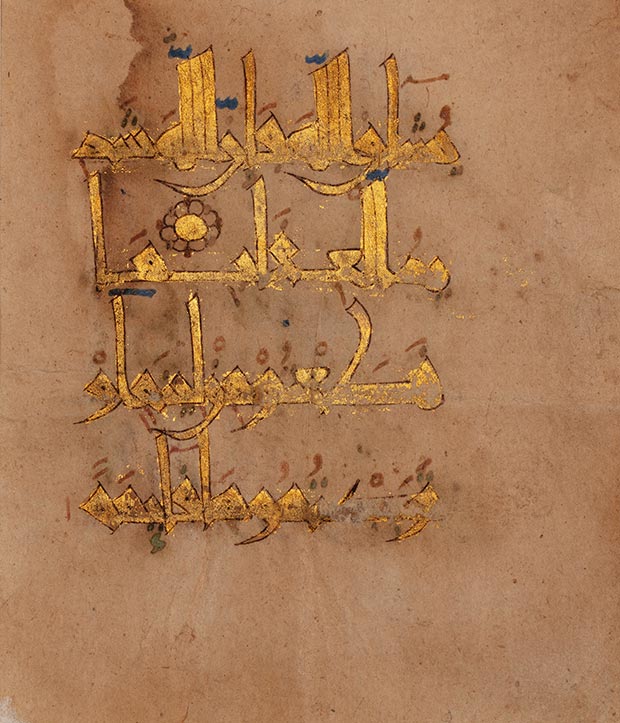 A very rare Qur'an leaf, Near East or North Africa, 11-12th century, C. 59:3-5, Arabic manuscript leaf on paper, 5ll. Written in fi ne gold kufi script, vocalisation and diacritic notes in blue and red, verse marker consisting of a rosette. Estimate: 4,000 / 6,000 Eur / Courtesy of Millon Auction House
A very rare Qur'an leaf, Near East or North Africa, 11-12th century, C. 59:3-5, Arabic manuscript leaf on paper, 5ll. Written in fi ne gold kufi script, vocalisation and diacritic notes in blue and red, verse marker consisting of a rosette. Estimate: 4,000 / 6,000 Eur / Courtesy of Millon Auction House
.jpg) Beautiful Caucasian Qur'an dated 1290H (1872), 34 x 22 cm. Signed: Hajiûn min Al-Yusef, walad (child) of 'Ali of the line of Al-ra'ji Al-Haqâsh. Arabic manuscript of 700 leaflets on paper, calligraphy in large black Naskh on ten lines per page, decorated with 6 illuminated pages, threads framing in red and blue, separation of verses in the shape of blue and red flowers alternating with green and red flowers. Titles are written in long, marginal illuminated cartridges. Juz is marked in the margins by a crescent between two circles. Estimate: 6,000 - 8,000 Eur / Courtesy of Millon Auction House
Beautiful Caucasian Qur'an dated 1290H (1872), 34 x 22 cm. Signed: Hajiûn min Al-Yusef, walad (child) of 'Ali of the line of Al-ra'ji Al-Haqâsh. Arabic manuscript of 700 leaflets on paper, calligraphy in large black Naskh on ten lines per page, decorated with 6 illuminated pages, threads framing in red and blue, separation of verses in the shape of blue and red flowers alternating with green and red flowers. Titles are written in long, marginal illuminated cartridges. Juz is marked in the margins by a crescent between two circles. Estimate: 6,000 - 8,000 Eur / Courtesy of Millon Auction House
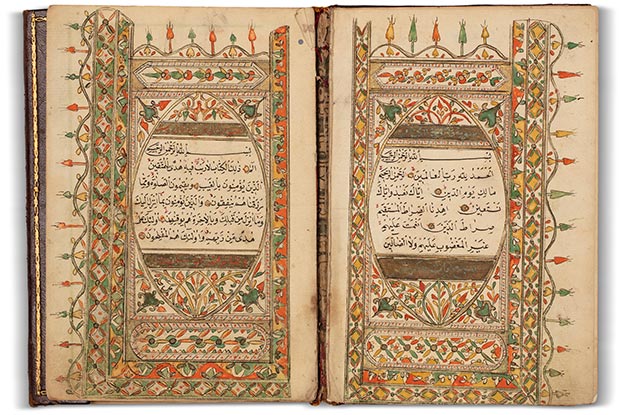 An illuminated Qur'an, signed and dated, Bucharest, Balkans 1283 AH/1872 AD. Estimate: 2,000 - 3,000 Eur/ Courtesy of Millon Auction House
An illuminated Qur'an, signed and dated, Bucharest, Balkans 1283 AH/1872 AD. Estimate: 2,000 - 3,000 Eur/ Courtesy of Millon Auction House
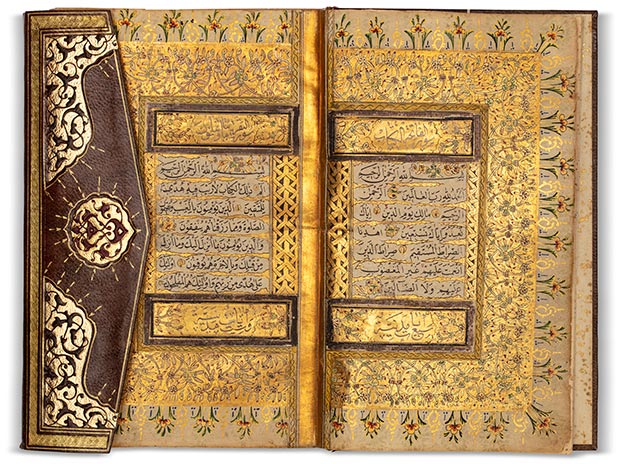 Ottoman Qur'an, dated 1257 AH., Turkey 1841. Signed Hasan al-Hasan al-Zuhdi al-Rizi ibn Yaqub 314ff …, 15 ll. Per page in naskh script in black ink. Frontispiece in double page. Some marginal illuminations of floral medallions.Titles of surah
inscribed in white on a gold background. Colophon in a gold illuminated plant medallion giving the name of the copyist. Estimate: 2,000 - 3,000 Eur / Courtesy of Millon Auction House
Ottoman Qur'an, dated 1257 AH., Turkey 1841. Signed Hasan al-Hasan al-Zuhdi al-Rizi ibn Yaqub 314ff …, 15 ll. Per page in naskh script in black ink. Frontispiece in double page. Some marginal illuminations of floral medallions.Titles of surah
inscribed in white on a gold background. Colophon in a gold illuminated plant medallion giving the name of the copyist. Estimate: 2,000 - 3,000 Eur / Courtesy of Millon Auction House
 A juz of an Ottoman Quran, Surat al-Anbiya copied by Zahirah daughter of Ali Pasha and dated 1270 H (1853 AD) written in very fine ornamental calligraphy. 25 x 17 cm. Estimate: 6,000 - 8,000Eur / Courtesy of Millon Auction House
A juz of an Ottoman Quran, Surat al-Anbiya copied by Zahirah daughter of Ali Pasha and dated 1270 H (1853 AD) written in very fine ornamental calligraphy. 25 x 17 cm. Estimate: 6,000 - 8,000Eur / Courtesy of Millon Auction House
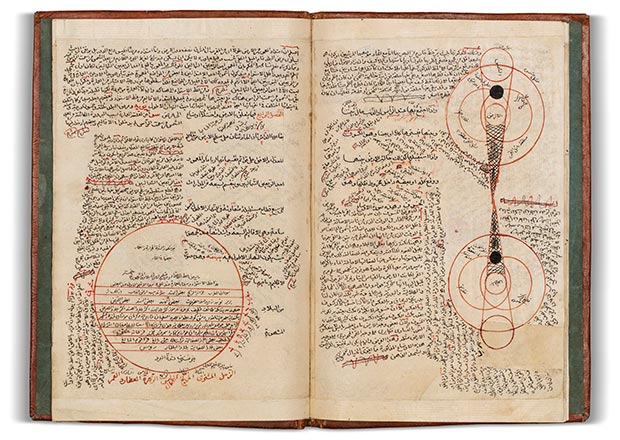 An Arabic scientific manuscript of 17 folios, written in black Naskh with designs concerning the position of the earth and the sun at different moments of the day in each country. Dated 1204 AH (1789 AD), 22 x 15 cm. Estimate: 1,500 - 2,000 Eur / Courtesy of Millon Auction House
An Arabic scientific manuscript of 17 folios, written in black Naskh with designs concerning the position of the earth and the sun at different moments of the day in each country. Dated 1204 AH (1789 AD), 22 x 15 cm. Estimate: 1,500 - 2,000 Eur / Courtesy of Millon Auction House
For the 1st time at Millon Auction House, the Islamic Arts auction includes Contemporary artists from North Africa and the Middle East, such as Mahjoub Ben Bella M. Aksouh and M. Khadda (Algeria), Ahmad Moualla, Jamal Bustan and Khaled Al-Saai (Syria), Charles Hossein Zenderoudi (Iran). All of their works are based on Arabic calligraphy. Jamal Bustan was in charge of Sheikh Maktoum's Mushaf for Dubai Mosque in 2003.
_Musical_Writing_2010_Oil_on_canvas.jpg) Ahmad Moualla (Damascus 1958), Musical Writing, 2010. Oil on canvas, 50 x 60 cm. Signed and dated lower left and back. Estimate: 2,000 - 3,000 Eur / Courtesy of Millon Auction House
Ahmad Moualla (Damascus 1958), Musical Writing, 2010. Oil on canvas, 50 x 60 cm. Signed and dated lower left and back. Estimate: 2,000 - 3,000 Eur / Courtesy of Millon Auction House
_Oriental_city_2008.jpg) Khaled Al-Saai (Syria 1970), Oriental City, 2008. Acrylic on paper mounted on cardboard, 55 x 40 cm. Signed lower left. Estimate: 1,000 - 1,200 Eur / Courtesy of Millon Auction House
Khaled Al-Saai (Syria 1970), Oriental City, 2008. Acrylic on paper mounted on cardboard, 55 x 40 cm. Signed lower left. Estimate: 1,000 - 1,200 Eur / Courtesy of Millon Auction House
An exceptional collection of 29 photographs of Saudi Arabia, circa 1880-1890s, some signed by Sadiq Bey and Abd al-Ghaffar Ch. Snouck Hurgronje, the earliest photographs of the Holy place of Islam. These extraordinary images record Hajj, showing, often for the first time, some of the Holy sites around Mecca and Medina.
Sadiq Bey was born in Cairo in 1832, where he trained as a military engineer after completing his studies at the École Polytechnique in Paris. It is not known when, or from whom, Sadiq Bey learned to take photographs but it was most probably through one of the resident photographers in Egypt. In 1861, prompted by the need to carry out more extensive military land surveys of the area between Wajh and Medina, Sadiq Bey made his first journey to Arabia. He took a camera along with his surveying equipment and took his first photographs of views at Medina. Sadly, however, none of the photographs from this first journey are known to have survived. In 1880 he was appointed the treasurer of the Mahmal, the ornate cloth to cover the Kaaba brought each year on a special litter to Mecca. In his capacity as treasurer, he accompanied the Mahmal to Medina and Mecca from September 1880 until January 1881. Again equipped with his camera, he succeeded in producing the series of photographs which are now considered to be some of the earliest known surviving photographs of the region, those of the Kaaba taken under great secrecy.
_Saudi_Arabia,_Mecca_ca1880-1881.jpg) Muhammad Sadiq Bey (1832-1902), Saudi Arabia, Mecca, c. 1880-1881 / Courtesy of Millon Auction House
Muhammad Sadiq Bey (1832-1902), Saudi Arabia, Mecca, c. 1880-1881 / Courtesy of Millon Auction House
Sadiq Bey published various accounts of his travels in Arabia in military journals and through the Emiry Grand Press in Cairo but the 1880/81 series of photographs appear to have been issued separately for wider distribution through the Socio Khadiviale de Geographie. The society's secretary, Dr Frederic Bonola, advertised sets of photographs for sale. In January and April 1880 Sadiq Bey gave a talk and report to the society on his earlier 1861 expedition, and on 20 May 1881 he presented a report on his recent journey to Mecca; detailed accounts were published in the society's bulletins, numbers 9/10 and 12. Among these is a very rare group of 9 original photographs by the first Meccan photographer Abd Al-Ghaffar taken in the 1880s, which show panoramic views of the city of Mecca, the Kaaba, and pilgrim tents.
Abd al-Ghaffar was a doctor practising in Mecca who was taught photography by Christian Snouck Hurgronje (1857-1936), a Dutch scholar who assumed the name Abd al-Ghaffar when he converted to Islam. Snouck Hurgronje stayed in Mecca from February 21 to July 5, 1885, and for some of his stay lived as a guest in the doctor's house, during which time he taught photography to his host. Snouck Hurgronje had travelled to Mecca in 1885 intending to participate in the Hajj and had taken a camera and equipment with him and made a number of photographs, but had to leave suddenly before the pilgrimage season due to a false accusation against him of plotting to take an important Aramaic inscription, the Tayma stele, for the Dutch. Snouck Hurgronje left many of his possessions behind, including his camera and equipment, with Al-Sayyid Abd al-Ghaffar. After Snouck Hurgronje had returned to Leiden, he asked the doctor to take photographs for him at sites including the pilgrims' camp by Mount Arafat and in the Mina Valley, as well as views of the city of Mecca and portraits of pilgrims and residents. Snouck Hurgronje reproduced a selection of Abd al-Ghaffar's photographs in two important (and rare) publications: Mekka (The Hague: M. Nijhoff, 1888-89) and Bilder aus Mekka (Leiden: Brill, 1889); see lots 302 and 303.
The auction will present also ceramics and metals from Mesopotamia, Ottoman Turkey, and Persia: a Nishapur pottery jar from the 10th century, an Iznik pottery border tile from Ottoman Turkey, dating circa 1580 and an earthenware planter, signed 'Th. Deck' with a deep green enamelled cover on a friezes decor.
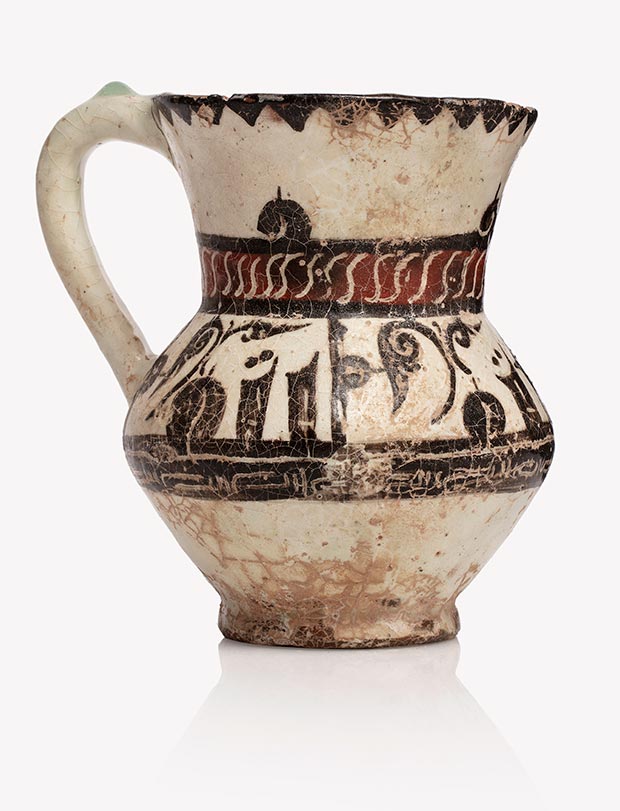 A Nishapur pottery jar, 10th century. Lustre-painted in black and white with a Kufic inscription decoration. Estimate: 2,000 - 3,000 Eur / Courtesy of Millon Auction House
A Nishapur pottery jar, 10th century. Lustre-painted in black and white with a Kufic inscription decoration. Estimate: 2,000 - 3,000 Eur / Courtesy of Millon Auction House
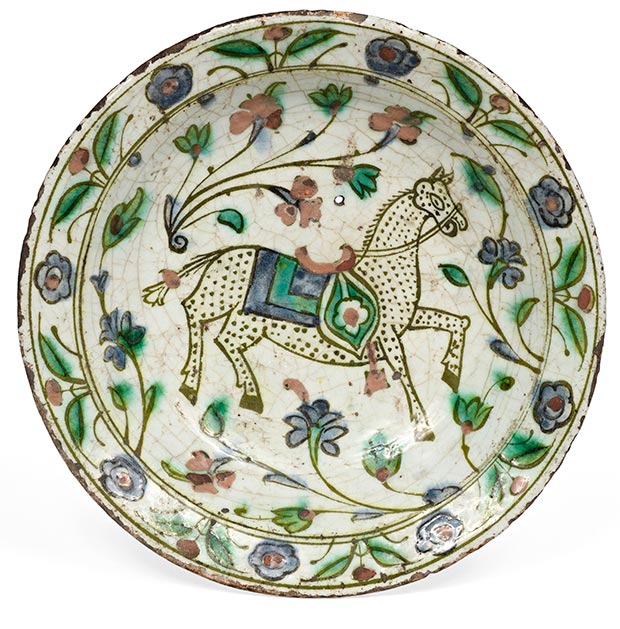 An Iznik pottery border tile, Ottoman Turkey, circa 1580. Estimate: 2,500 / 3,000 Eur / Courtesy of Millon
An Iznik pottery border tile, Ottoman Turkey, circa 1580. Estimate: 2,500 / 3,000 Eur / Courtesy of Millon
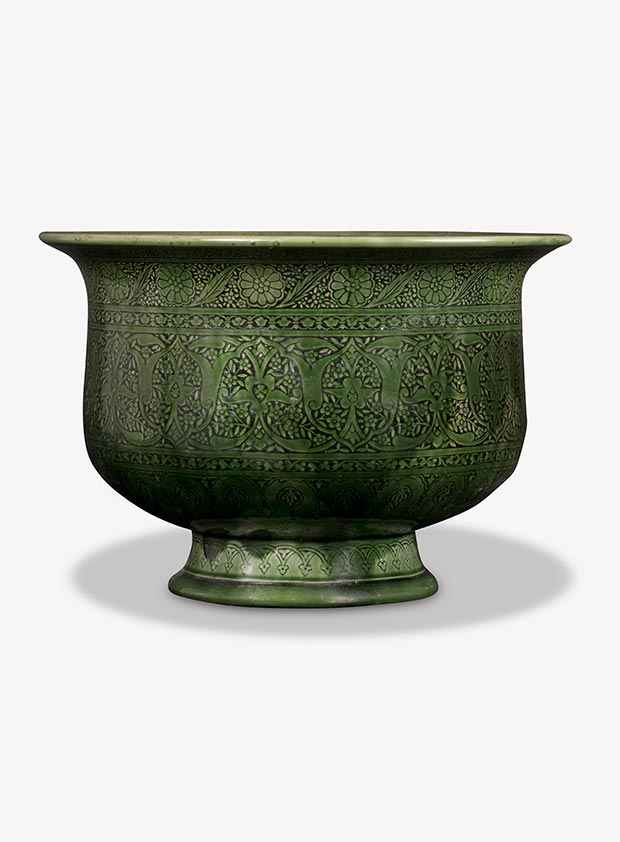 An earthenware planter. Signed Th. Deck with a deep green enamelled cover on a friezes decor. Estimate: 1,800 - 2,200 Eur / Courtesy of Millon Auction House
An earthenware planter. Signed Th. Deck with a deep green enamelled cover on a friezes decor. Estimate: 1,800 - 2,200 Eur / Courtesy of Millon Auction House
From the craftsman Ibrahim ibn Sa'id al-Sahli working in Toledo, Millon offers four astrolabes and a signed celestial globe, as well as an unsigned celestial globe that can be attributed to him. These instruments date between H459-478 (1066/7- 1085/6). They are characterized by Elegant Western Elegant Calligraphy and a very precise line of lines and divisions.
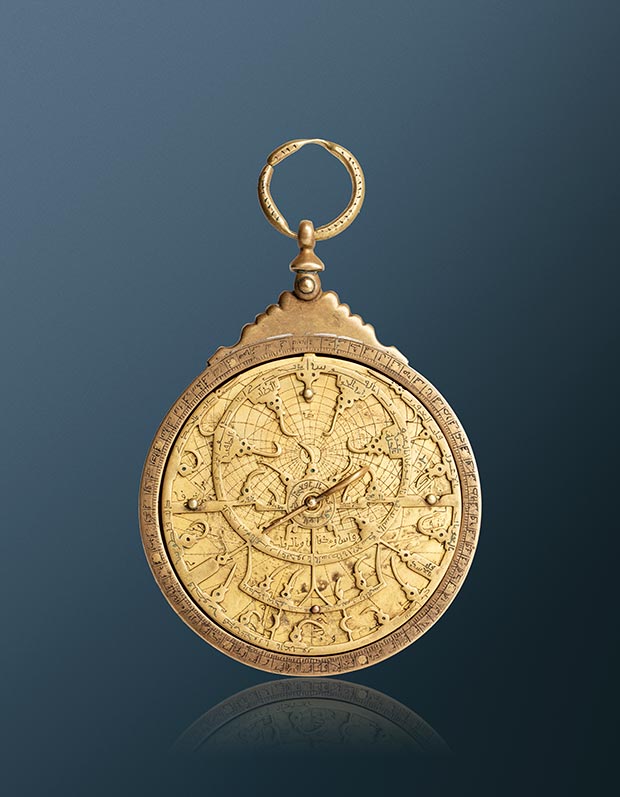 Maghrebian Astrolabe with the name Ibrahim ibn Sa'id al-Sahli on the throne, 19th century. Brass, D. 125 mm, inscriptions in colours. Estimate: 20,000 - 30,000 Eur / Courtesy of Millon Auction House
Maghrebian Astrolabe with the name Ibrahim ibn Sa'id al-Sahli on the throne, 19th century. Brass, D. 125 mm, inscriptions in colours. Estimate: 20,000 - 30,000 Eur / Courtesy of Millon Auction House
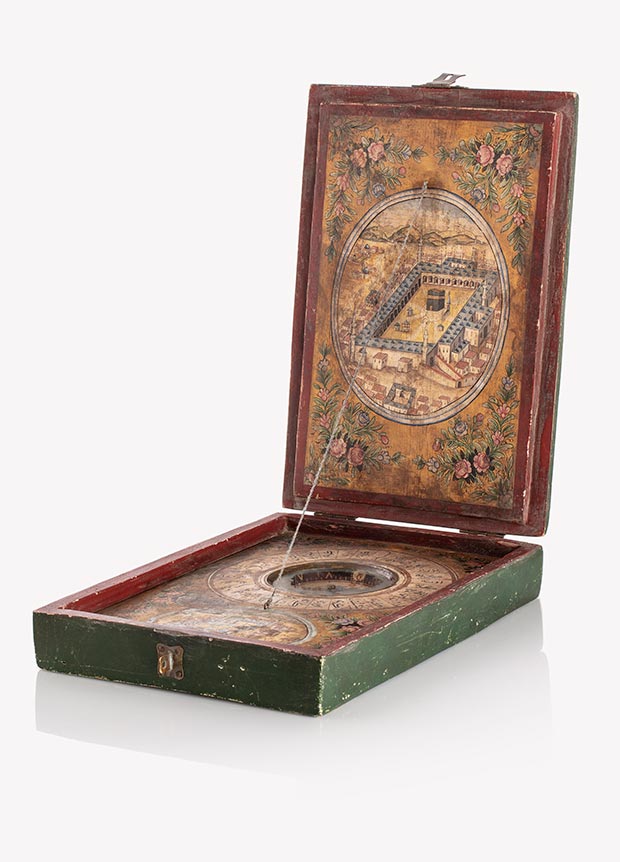 Large compass and indicator of Qibla, late 18th- early 19th century, with miniatures representing the sacred sites of Mecca and Medina. Painted wood, hinges and brass closure, 26.3 cm x 17.9 cm. Estimate: 6,000 - 8,000 Eur / Courtesy of Millon Auction House
Large compass and indicator of Qibla, late 18th- early 19th century, with miniatures representing the sacred sites of Mecca and Medina. Painted wood, hinges and brass closure, 26.3 cm x 17.9 cm. Estimate: 6,000 - 8,000 Eur / Courtesy of Millon Auction House
Comments
Add a comment